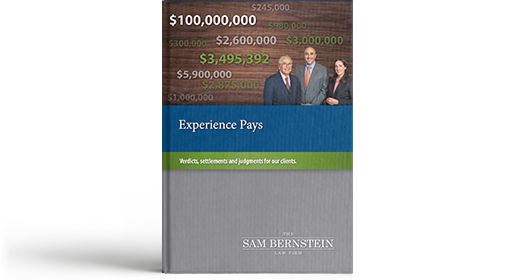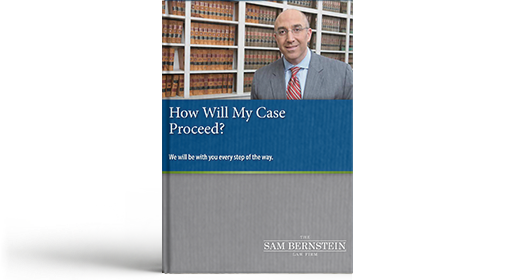REFLEX SYMPATHETIC DYSTROPHY LAWYER
If you're experiencing Reflex Sympathetic Dystrophy (RSD) as a result of an accident, contact The Sam Bernstein Law Firm to get the compensation you deserve.
MICHIGAN REFLEX SYMPATHETIC DYSTROPHY LAWYER
Reflex sympathetic dystrophy, more commonly referred to as RSD, is a chronic neurological syndrome that frequently results in debilitating pain. The condition is also known as Complex Regional Pain Syndrome or CRPS. If you or a loved one suffers from Reflex Sympathetic Dystrophy (RSD), contact us to get in touch with an RSD attorney.
Although there is still much to learn about this disease and most people do not clearly understand the condition and cases of RSD were reported as far back as the American Civil War. As Michigan's most experienced personal injury law firm, we have the knowledge needed to help you and your loved ones received the compensation you deserve. Our team of RSD attorneys have over 600 years of combined legal experience and are ready to begin fighting for you today!
WHAT IS REFLEX SYMPATHETIC DYSTROPHY?
Reflex sympathetic dystrophy, or RSD, often develops due to a problem in your sympathetic nervous system. The sympathetic nervous system is responsible for controlling your blood flow which helps to regulate your blood pressure and heart rate.
Normally, when you get injured, the sympathetic nervous system tells your blood vessels to decrease in size, so your blood loss is minimized from your injury. Later on, your sympathetic nervous system tells the blood vessels to open back up to allow blood to flow to the damaged area to start repairing it. Individuals with RSD have a different reaction in their bodies. If you have RSD, your sympathetic nervous system has mixed signals, causing it to turn on after an injury but it fails to turn back off. The result of these mixed signals is a rise in swelling and pain at the site of your injury.
CAUSES OF RSD
A broken bone, a nerve injury, or another soft tissue injury that does not follow a normal course of healing, can trigger RSD. This condition occurs in about 1% to 2% of all fractures. It has a higher occurrence in people who suffered a Colles fracture of the wrist. A Colles fracture is a total fracture of the radius bone in the forearm near the wrist, which results in a posterior (upward) displacement of the radius and causes an obvious deformity.
A common myth about RSD is that it only results from catastrophic injury. In fact, RSD frequently results from minor injuries, such as sprains or falls. Prolonged immobilization of a limb, through a cast or other means, is another cause of RSD. It also may occur in individuals after competently performed surgeries. In some instances, it materializes without any identifiable cause.
Because there are so many causes for RSD, it can be connected to another party’s negligence in several different types of cases. You may be entitled to compensation if someone else is responsible for your injury and development of RSD.
SIGNS AND SYMPTOMS OF REFLEX SYMPATHETIC DYSTROPHY
If you believe you have reflex sympathetic dystrophy, there are some common signs and symptoms that are indicators of RSD. These include:
- Continuous throbbing or burning pain
- Swelling of the painful area
- Sensitivity to cold or touch
- Joint swelling, stiffness, or other damage
- Changes in skin color or temperature
- Muscle spasms or weakness
- Changes in skin texture
- Decreased ability to move the affected body part
- Changes in nail and hair growth
If you or a loved one suffers from Reflex Sympathetic Dystrophy (RSD), contact us as soon as possible for an RSD attorney.
MORE INFORMATION ON REFLEX SYMPATHETIC DISORDER:
SYMPTOMS AND TREATMENTS OF RSD
THE MOST COMMON SYMPTOMS OF RSD INCLUDE:
- Severe burning pain
- Pathological changes to bone and/or skin
- Excessive sweating
- Excessive tissue swelling
- Extreme sensitivity to touch in the affected area
- Movement disorders (i.e. tremors, spasms, hyper reflexes, difficulty with movement)
- Frequent infections
- Recurrent migraine headaches
According to the Reflex Sympathetic Dystrophy Syndrome Association of America, RSD spreads to other parts of the body in 70% of reported cases.
Medical professionals recognize two RSD subgroups: Type I and Type II. This distinction is based on the treating physician’s ability to identify an underlying nerve injury.
In Type I cases, the individual suffered no specific underlying nerve injury.
In Type II (sometimes called causalgia), there was a distinct major nerve injury at the start of the condition.
Several different treatments are available for victims of RSD. If you believe you may suffer from this condition, you should seek treatment immediately from a competent physician. Treatment options include medication, physical therapy, psychological support, pain management support, sympathetic nerve blocks, sympathectomy, dorsal column stimulator, and other possible approaches to combating the disease. Even if treated early and properly, the disease may be chronic and the pain may worsen.
RSD is not a psychological condition. Cases may range from mild to severe, but the pain is very real. The Social Security Administration recognizes RSD as a potentially disabling disease.
If you or a loved one suffers from Reflex Sympathetic Dystrophy (RSD), contact us as soon as possible.
Client reviews

"THEY KEPT ME UPDATED."
- Veronica, Actual Client

"I WILL BE FOREVER GRATEFUL."
- Tim, Actual Client

"I FELT LIKE I WAS A PART OF THE FAMILY"
- Terrence, Actual Client

"VERY PROFESSIONAL & KNOWLEDGEABLE"
- Sherry, Actual Client

"PASSIONATE, COMPETENT, COMMITTED"
- Actual Client

"THEY STAND BY THEIR WORD."
- Actual Client

"KIND & COMPASSIONATE"
- Nancy, Actual Client

"YOU CAN TRUST THEM 100%."
- Michael, Actual Client

"HONEST, CARING, SUPPORTIVE."
- Janice, Actual Client

"THEY TOOK PERSONAL INTEREST IN ME."
- Janice, Actual Client

"I KNEW I WAS IN GOOD HANDS"
- Jerry, Actual Client

"NUMBER ONE PERSON I'D RECOMMEND."
- Actual Client

"SAM'S GOT YOU COVERED."
- Chris, Actual Client
RECOMMENDED READING

What Are Your Rights as a Patient?...
When you are admitted to a hospital or move into a nursing h Read more…



